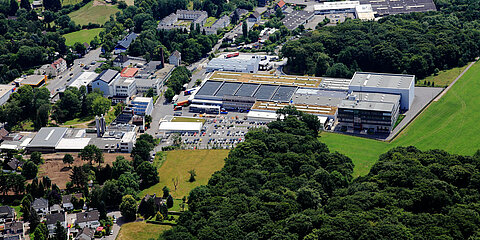
The beginnings of the Coroplast Group The founding family of Carl Müller
The year 1928 Fritz Müller – one man, one room, one company
On February 3, 1928, the family’s 25-year-old son Fritz Müller founded the company “Fritz Müller Elektroisoliermaterial” in Wuppertal. He rented a room in the city center for the young company. With a loan of 6,000 reichsmark, courage, and conviction, he paved the way for today’s Coroplast Group. As the company name “Fritz Müller Elektroisoliermaterial” reveals, the sales program at that time consisted of materials for electrical insulation. Müller organized material purchasing and sales and had the fabric insulation hoses manufactured in contract work. This contract manufacturing is common in the textile industry in Wuppertal.
Fritz Müller also sold insulating materials such as hard papers, oil linen, and oil silk. In the same year, Fritz Müller began independent production for the first time: He impregnated oil hoses with impregnating paints in baking ovens. Previous attempts had inspired him: Fritz and his brother had gained experience in the processing of paints in the business of their father Carl. The brothers liked experimenting; there is a story that they tried to impregnate oil hoses and put them in their mother’s oven for drying. One thing is sure, however, the systematic development of their own production company began toward the end of 1928.

1929 to 1934 World economic crisis overcome
The small company with five employees produced textiles, lacquered hoses, and varnished cables for cars (copper braided conductors) in 1929. In addition, the company even bought its own car. Customers included well-known machine manufacturers such as AEG and automobile manufacturers. The stock market crash in New York and the ensuing world economic crisis had a serious impact – and Fritz Müller was no exception. The young company was on the verge of ruin, but creditors trusted the company and ensured its survival.
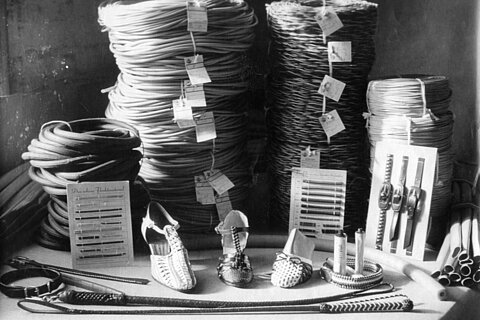
1935 to 1943 Business looking up with PVC and suffering due to war
In the mid-1930s, a promising thermoplastic was launched on market: polyvinyl chloride – PVC for short. Fritz Müller recognized the potential of this novel material and began to process it. Thanks to PVC, copper-containing, insulated wires could then also be produced, for example for lighting and telephone systems. Despite the danger of failure when processing the new material due to lack of experience, Fritz Müller bought his first extruder – a machine specially designed for processing thermoplastics. His courage paid off: As one of the first users of PVC, Coroplast developed valuable know-how in this field, which laid the foundation for success in plastics processing. The number of machines, sales, and employees increased. Production continued during the war years, partly in Saxony. In 1943, the Wuppertal factory was hit by bombs, destroying large amounts of raw materials.
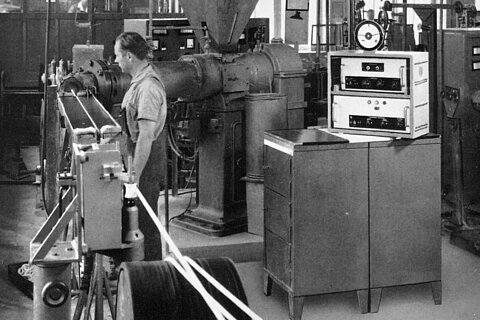
Owner Fritz Müller was considered a trustworthy, industrious businessman. The company had developed very well and gained considerable importance, especially during the preceding years.
The year 1945 Founder Fritz Müller dies during a robbery
Fritz Müller risked a new start at the Wuppertal plant, even before the war had ended. He once again started producing insulated sleeving, insulating hoses, and artificial leather straps. But the new beginning was overshadowed by the death of the company founder: On June 5, 1945, he died in a robbery in the emergency shelter on the company premises. He was staying with his family because his apartment was destroyed by bombs. His wife Anna Müller died only one year later.
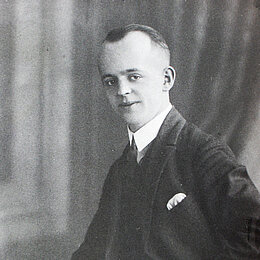
1946 to 1948 The Coroplast brand name was created
The chemist and graduate in business administration Dr. Richard Röhm joined the company as managing director. He expanded the company and introduced new products. Consequently, the company began to assemble cables and offer them in the form of complete cable sets and large-scale cables. In 1948, the uniform and catchy brand name Coroplast was created, which quickly became synonymous with the company name “Fritz Müller.”
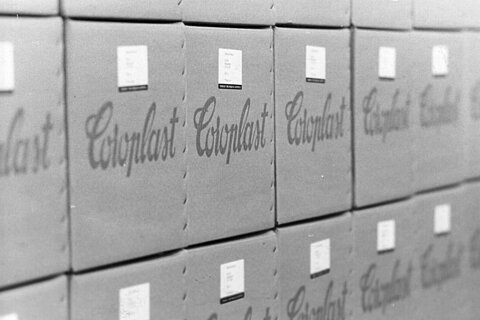
The 1950s PVC – the material from which miracles are made.
They started with “poly” and had a massive impact on the economic upswing: polyvinyl chloride, or PVC for short, and materials such as polyethylene and polypropylene. Coroplast invested a great deal of development work in its own laboratories and technical testing department. The company had the ambition to manufacture as much as possible in-house, including developing its own plastic compounds and making its own machinery. The employees combined adhesive with PVC and created numerous types of insulating tape, anti-corrosion bindings, and multi-purpose adhesive tapes. The persistent research, experimentation, and continual improvements soon made the company a success. Coroplast continued to grow, its products were on sale in 50 countries worldwide, the workforce increased to almost 500 people, and new buildings provided space for further production equipment.
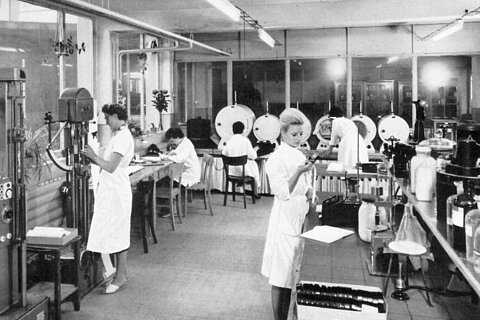
1960 to 1975 Freed from solvents, caught in recession
The love of experimenting and courage paid off. Coroplast introduced a new type of acrylate adhesive to the market in the early 1960s. This solvent-free and therefore environmentally friendly adhesive is still in use by Coroplast today. Innovation was accompanied by expansion – a new building and additional, more efficient machinery enhanced the Wuppertal plant.
Oil crisis, car-free Sundays, and recession: Perhaps older readers can remember the driving bans that existed in the early 1970s. Growth in the industrialized countries appeared to have reached its limits, and even Coroplast felt the pinch. Despite record sales in 1974, the following year proved to be the most difficult in the company’s more recent history, with redundancies, the loss of customers and a fire on the company premises.

The year 1976 The era of Dr. Kurt Müller shaped the next 30 years.
During the 1950s, Dr. Kurt Müller, nephew of the founder Fritz Müller, had worked from time to time in his uncle’s company. In 1961, the economist and engineer Dr. Kurt Müller became an authorized signatory for the company and was responsible for the technical division. He became head of the company as solely responsible managing director in 1976. He ran the company for the next 30 years and had formative influence on it.

The year 1985 From wiring harnesses to high-tech cable assemblies
In the mid-1980s, Coroplast started manufacturing and marketing wire harnesses. Using cables and adhesive tape manufactured in-house, the company produced entire cable harnesses for customers from the automobile, electrical, and household appliances industries. The cable harnesses – also known as vehicle electrical distribution systems – supply engines, electromagnetic valves, and lighting systems with electricity. Moreover, they transfer information from and between the various control units. The decision to expand the cable harness assembly business unit was a real turning point in the company’s history: In the early 1990s, cable assembly and business with the automotive industry became an important pillar of Coroplast.

The year 1994 Out into the big wide world – internationalization begins in Poland
The crisis that hit the automotive industry in the early 1990s also had a significant impact on Coroplast. However, the company turned the crisis to its advantage and positioned itself more and more as a developer of vehicle electrical distribution systems for increasingly complex automotive cabling technologies. In 1994, Coroplast first ventured abroad and founded the subsidiary Coroplast sp. zo.o. Dylaki Poland. Coroplast began by manufacturing wire harnesses on the former premises of a textiles factory close to the Upper Silesian town of Opole. This was later followed by two further sites in Poland. In 1999, the company crossed the Atlantic, and Coroplast opened a production plant in Central Mexico due to the proximity to the North American automotive market and the VW plant in Mexico.

The year 1999 Natalie Mekelburger became a member of the management board
The company and therefore its headquarters in Wuppertal continued to grow steadily. Like her father Dr. Kurt Müller before her, Natalie Mekelburger had not originally intended to work at Coroplast. However, after completing her studies and getting initial professional experience, in 1994, she joined the family-run company as Sales and Marketing Manager. She became one of three members of the management board in 1999.

2000 to 2008 Service offensive in Germany – unchartered territory in China
Always being there for the customer, researching together with customer experts and closely coordinating new developments is best achieved if you are close to the customer. That is why Coroplast opened two more branches within Germany at the turn of the millennium. Since 2000, the Service Center in Wolfsburg has been dedicated to designing and developing wire harnesses for the VW Group. Coroplast has worked together with the VW subsidiary Audi in Ingolstadt since 2005.
In 2004, Coroplast took its first step into the Asian market, establishing Coroplast Harness Technology Co., Ltd. in Taicang, China, a city located approx. 40 kilometers from Shanghai. The move marked the beginning of an impressive story of growth on the Asian market, which still continues today.

The year 2008 Top Employer for the first time
The claim “Relations that retain” also applies to the company’s employees. Employees at Coroplast enjoy great job security, flexible working time models with a good work-life balance, and fast promotion opportunities. In addition, employees profit from numerous benefits, including free access to a gym. The CoroAcademy offers a wide range of further training opportunities. In 2008, Coroplast was awarded the title of one of Germany’s top employers for the first time. The positive corporate culture, the good working atmosphere, further training opportunities, and the promotion of health were particularly convincing aspects. In 2020, the highly coveted title of “Top Employer” was awarded to Coroplast for the 12th time.
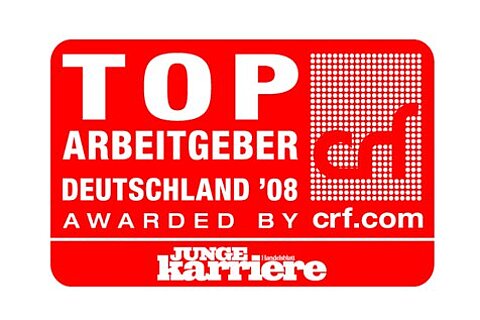
2010 to 2013 On the right track toward an international production network
Wherever vehicles are built, Coroplast is not far away. In 2010, Coroplast entered a new continent and has produced cable harnesses in Tunisia ever since. One year later, Coroplast began manufacturing wire harnesses in Acámbaro, Mexico. Approx. 250 kilometers from Mexico City, the location has enormous potential with its direct access to the North, Central, and South American automotive markets. Its customers already include Audi, VW, and Daimler. Coroplast inaugurated no fewer than three new sites in 2013. Two of them are located in China, in Kunshan and Mianyang, and one is in Hammamet, Tunisia.
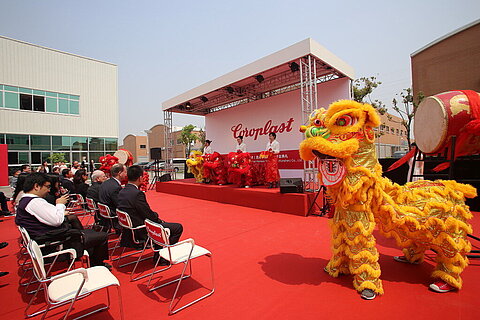
The year 2014 Competence center for technical adhesive tapes
In 2014, Wuppertal celebrated the “Grand Opening” of its competence center for technical adhesive tapes. The centerpiece of the new building is an internally developed adhesive tape coating system. With the construction of the new production building, Coroplast extended its spatial capacity by 50 percent. The company also opened its first production site in North America. Coroplast manufactures technical adhesive tapes at its location in Rock Hill, South Carolina. The highlight of the year: Coroplast won the Wuppertal Business Award. The company’s investment in Wuppertal as an industrial location and its commitment to social issues and culture were the main factors that convinced the jury.

The year 2015 We sadly mourned the passing of Dr. Kurt Müller.
Dr. Kurt Müller, managing director of many years’ standing, died on May 31, 2015 at the age of 85. He headed the company for almost 40 years and was crucial to its success, particularly when times were tough. With his sure instinct for the market and the right products, he provided the decisive impulses that transformed a regional manufacturer with a relatively limited export volume into the globally operating technology leader we know today.

The year 2016 Business award for commitment to art
Art in the buildings, sculptures in the staff park, a company art award known as CoroArt: Coroplast has a history of supporting art and culture in Wuppertal and the surrounding region. In November 2016, the company was presented with the “Nadel der Medici” business award for its exceptional commitment to art. Coroplast has also sponsored Wuppertal’s Von der Heydt Museum and the Von der Heydt Art Gallery for many years. With free guided tours for its employees and a “Cultural Evening” for guests from the worlds of culture, politics, and industry, Coroplast regularly invites guests to be inspired by art at the museum. The art highlight of 2016 was the exhibition of the works of Britain’s most eminent sculptor Tony Cragg at the Von der Heydt Museum.

We are committed to culture, because this field really reflects the soul of the company. A creative environment also helps to promote creative thinking.
The year 2017 Growth – worldwide and in Wuppertal
The trend to internationalization continued. Numerous plants abroad were enlarged and upgraded. For example, the plant in Poland’s Strzelce Opolskie was given a new production hall, the plant in American Rock Hill (see photo) almost doubled in size, and the production area in Mexico’s Acámbaro was almost tripled in size during operation. At the Chinese business site Kunshan, Coroplast Tape Technology is founded as a new subsidiary and in Moldova, a completely new Coroplast business site is established. In addition to the international expansion, the head office of Wuppertal also grew.
Highlight at the end of the year The “EY Entrepreneur of the Year 2017” award presented to our President & CEO Natalie Mekelburger.
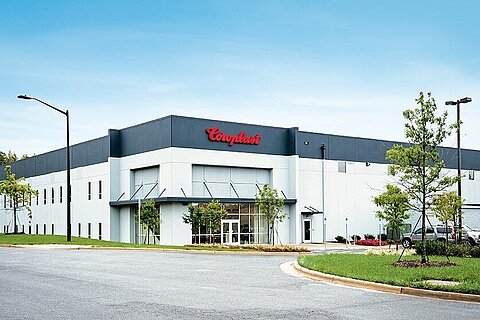
The year 2018 Coroplast celebrates 90th Anniversary
Commemorative speech, domino rally, and a very good mood: This is how we started our anniversary year together on February 19. But we didn’t want it just to be an event for our employees at our headquarters in Wuppertal. This event was the ideal occasion for us to connect and strengthen our Coroplast teams across all borders and from all business units. That’s why we had all our international locations connected live. The rest of the year was full of events, sports events, and guided tours of the production and development halls for our employees at the Wuppertal location – with a crowning conclusion: The Christmas party in the style and splendor of the “golden twenties.” Natalie Mekelburger stated it succinctly: “90 years – it’s great that we had the opportunity to celebrate this long and successful tradition with our employees. Personally, the kick-off event got under my skin. In this sense, we hope to celebrate the next anniversary together in ten years’ time.”

The year 2020 Coroplast prepares for the future
The automotive industry is undergoing profound change worldwide. As part of the automotive supply chain, the Coroplast Group is actively shaping these developments to maintain its position as a powerful and flexible technology leader. Above all, the company is concerned with giving its three business units a clearer identity and positioning themselves more clearly. This targeted focus on their core competencies will enable companies to become more focused and powerful in the future. Each business unit will have a globally independent brand image. Coroplast headquarters uses the additional designation of Group to the established brand name Coroplast. The Business Unit Technical Adhesive Tapes is using the additional designation of Tape. The Business Unit Wires & Cables is now called Coroflex. The Business Unit Wire Harnesses will use the name WeWire.
THE YEAR 2021 Coroplast Group Sustainability Initiative
The Coroplast Group Sustainability Initiative (CSI) is launched. The initiative consolidates all activities relating to the wide range of sustainability topics. The Sustainability Report for 2020 is the first important publication to emerge from the family-owned company's overarching sustainability strategy. It provides a broad overview of the company's activities and the innovation activities of the entire corporate group. Already by the end of 2021, a concrete plan for reducing greenhouse gas emissions will be developed for the entire corporate group. In the long term, the company has set itself the goal to be climate neutral - across all its sites worldwide.
